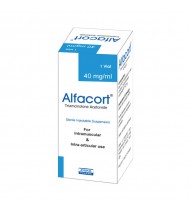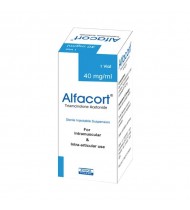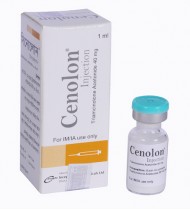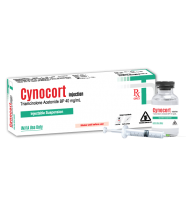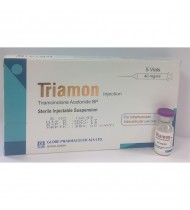Triamcinolone Acetonide (Injection)
Indications
Pharmacology
Dosage & Administration
Children 6 to 12 years: Initial dose is 40 mg
Interaction
Amphotericin B injection and potassium-depleting agents: When corticosteroids are administered concomitantly with potassium-depleting agents (ie, amphotericin B, diuretics), patients should be observed closely for development of hypokalemia. There have been cases reported in which concomitant use of amphotericin B and hydrocortisone was followed by cardiac enlargement and congestive heart failure.
Antibiotics: Macrolide antibiotics have been reported to cause a significant decrease in corticosteroid clearance.
Anticholinesterases: Concomitant use of anticholinesterase agents and corticosteroids may produce severe weakness in patients with myasthenia gravis. If possible, anticholinesterase agents should be withdrawn at least 24 hours before initiating corticosteroid therapy.
Anticoagulants, oral: Coadministration of corticosteroids and warfarin usually results in inhibition of response to warfarin, although there have been some conflicting reports. Therefore, coagulation indices should be monitored frequently to maintain the desired anticoagulant effect.
Antidiabetics: Because corticosteroids may increase blood glucose concentrations, dosage adjustments of antidiabetic agents may be required.
Antitubercular drugs: Serum concentrations of isoniazid may be decreased.
Cholestyramine: Cholestyramine may increase the clearance of corticosteroids.
Cyclosporine: Increased activity of both cyclosporine and corticosteroids may occur when the two are used concurrently. Convulsions have been reported with this concurrent use.
Digitalis glycosides: Patients on digitalis glycosides may be at increased risk of arrhythmias due to hypokalemia.
Estrogens, including oral contraceptives: Estrogens may decrease the hepatic metabolism of certain corticosteroids, thereby increasing their effect.
Hepatic enzyme inducers (eg, barbiturates, phenytoin, carbamazepine, rifampin): Drugs which induce hepatic microsomal drug metabolizing enzyme activity may enhance the metabolism of corticosteroids and require that the dosage of the corticosteroid be increased.
Ketoconazole: Ketoconazole has been reported to decrease the metabolism of certain corticosteroids by up to 60%, leading to an increased risk of corticosteroid side effects.
Nonsteroidal anti-inflammatory drugs (NSAIDs): Concomitant use of aspirin (or other nonsteroidal anti-inflammatory drugs) and corticosteroids increases the risk of gastrointestinal side effects. Aspirin should be used cautiously in conjunction with corticosteroids in hypoprothrombinemia. The clearance of salicylates may be increased with concurrent use of corticosteroids.
Skin tests: Corticosteroids may suppress reactions to skin tests.
Vaccines: Patients on prolonged corticosteroid therapy may exhibit a diminished response to toxoids and live or inactivated vaccines due to inhibition of antibody response. Corticosteroids may also potentiate the replication of some organisms contained in live attenuated vaccines. Routine administration of vaccines or toxoids should be deferred until corticosteroid therapy is discontinued if possible.
Contraindications
Side Effects
Pregnancy & Lactation
Precautions & Warnings
Use in Special Populations
Use in children: As corticosteroids can suppress growth, the development of infants and children on prolonged corticosteroid therapy should be carefully observed. Caution should be taken in the event of exposure to chicken pox, measles or other communicable diseases. Children should not be vaccinated or immunized while on corticosteroid therapy. Corticosteroids may also affect endogenous steroid production.
Overdose Effects
Therapeutic Class
Storage Conditions
Alfacort IM/IA Injection 1 ml vial
IndicationsPost-traumatic osteoarthritis, synovitis of osteoarthritis, rheumatoid arthritis, acute a..
60.00Tk.
Alfacort IM/IA Injection 1 ml vial
IndicationsPost-traumatic osteoarthritis, synovitis of osteoarthritis, rheumatoid arthritis, acute a..
60.00Tk.
Cenolon IM/IA Injection
IndicationsPost-traumatic osteoarthritis, synovitis of osteoarthritis, rheumatoid arthritis, acute a..
75.00Tk.
Cynocort IM/IA Injection 40 mg/ml
IndicationsPost-traumatic osteoarthritis, synovitis of osteoarthritis, rheumatoid arthritis, acute a..
70.00Tk.
Trialon IM/IA Injection 1 ml vial
IndicationsPost-traumatic osteoarthritis, synovitis of osteoarthritis, rheumatoid arthritis, acute a..
75.00Tk.
Triamon IM/IA Injection 40 mg/ml
IndicationsPost-traumatic osteoarthritis, synovitis of osteoarthritis, rheumatoid arthritis, acute a..
70.00Tk.

